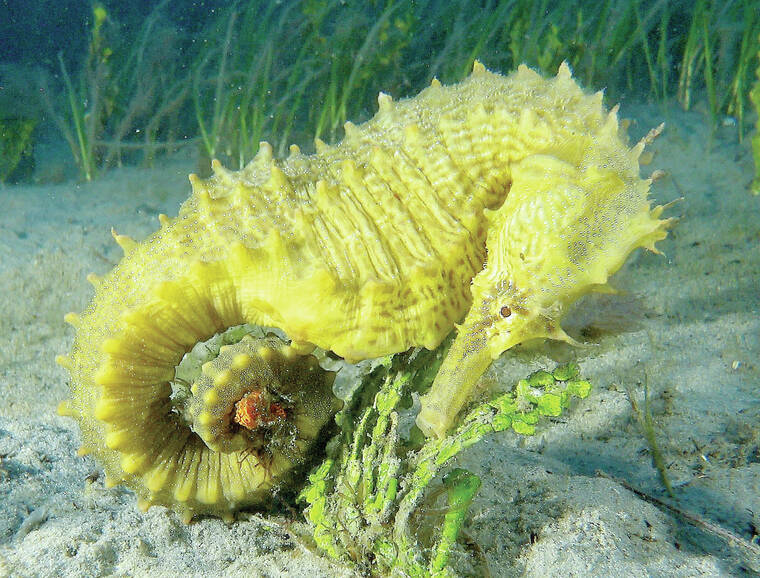We have native seahorses here in Hawai‘i, but they are quite rare. But in other Pacific islands, like the Philippines, they are super common. I always wondered why, but after learning how they mate and produce offspring, I now understand why we rarely see them in Hawaiian waters.
Seahorses are fish that swim upright and have a prehensile tail fin for holding onto the sea floor. They swim slowly, but when a small fish or shrimp comes close by, they grab their food with lightning speed. Seahorses like calm bays and lagoons, and they hold onto limu or seaweed on the bottom, remaining quite camouflaged so they are super hard to see. Hawai‘i does not have a lot of calm bays, but we do have a lot of big surf, and this is not good for seahorses to find each other for mating.
Seahorse mating has to be the most unusual behavior for any fish in the sea, because the male and female seahorse take months to reproduce, and it is the male that has the babies. When a female seahorse finds a suitable male, she performs a courtship dance with him every day for up to several months to determine if he will be a dutiful and reliable dad.
The pair live separate at night, but each morning the female swims over to the male’s territory, bows her head, and they start what looks like a ballroom dance. They even wrap their tails together like holding hands. They repeat this dance every day, and it is quite romantic to watch.
When the female has ripe eggs, the male will fertilize them, then the female will deposit the eggs in a pouch on the male’s belly during one of their dances. The female’s eggs are only ripe for a few days, so she has to know her partner is going to be there for her at the right time, so getting to know and trust him is very important.
After she gives her eggs to the male, they continue their daily dance, and the male gives live birth to hundreds of babies at night in 10 to 15 days. Shortly after giving birth, the female starts a new daily dance and gives the male some more eggs to keep him busy being pregnant.
The seahorse pair may produce several clutches of babies in a row, so they need to be close to each other every day for the process to work. This is easy to do in a calm bay with lots of good seahorse habitat, but in Hawai‘i one or both of the seahorses will get washed away in the surf before the male can become pregnant.
You can see the seahorse in action in my underwater educational movie series up at underwater2web.com and YouTube at Underwater2web. I will have a new movie out soon all about the romantic life of the seahorse, and if you subscribe to my YouTube, you will get it first as soon as it is finished.
•••
Terry Lilley is a marine biologist living in Hanalei. He is co-founder of Reef Guardians Hawai‘i, a nonprofit on a mission to provide education and resources to protect the coral reef. To donate to Reef Guardians Hawai‘i, go to www.reefguardianshawaii.org.


